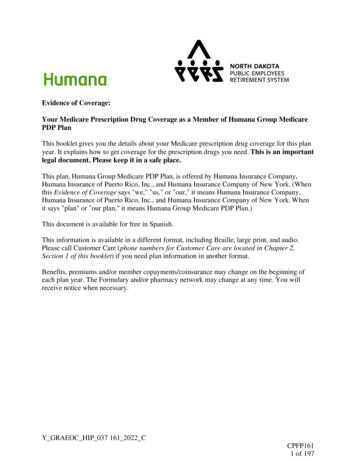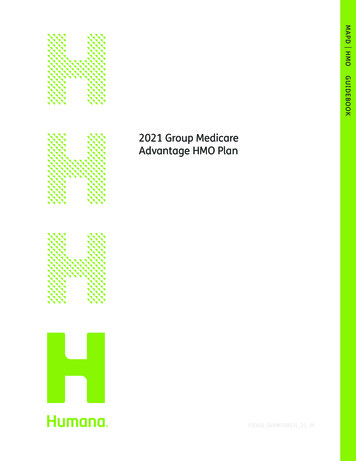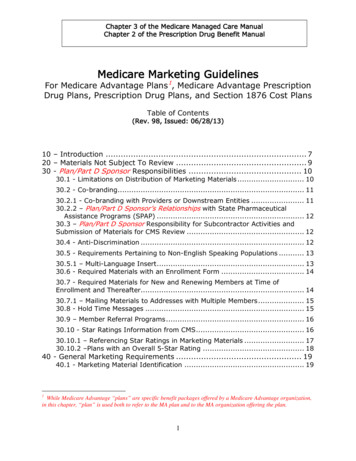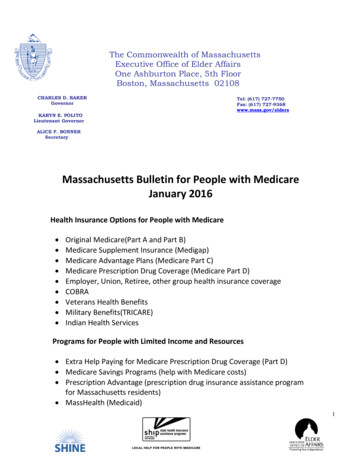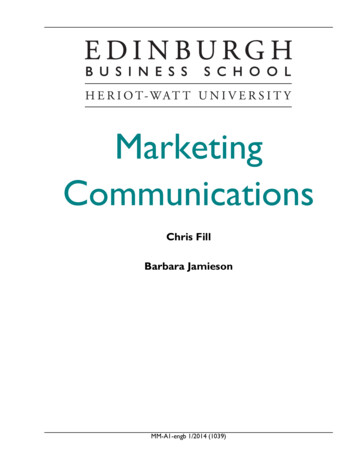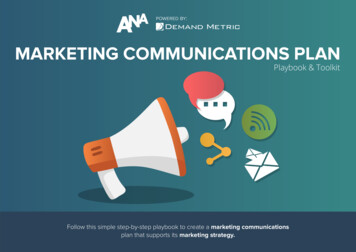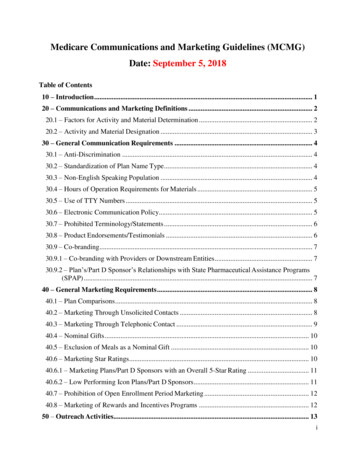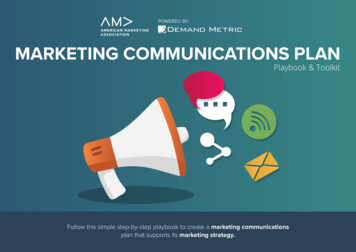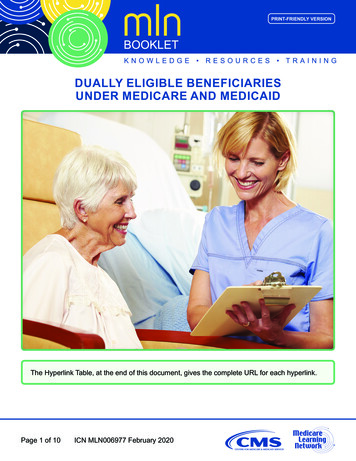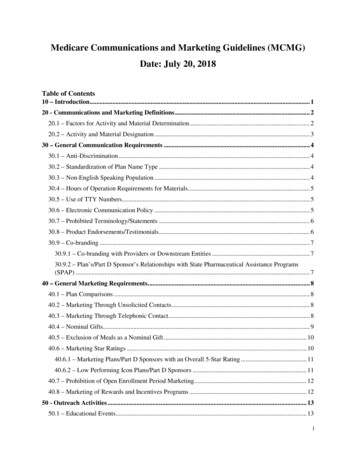
Transcription
Medicare Communications and Marketing Guidelines (MCMG)Date: July 20, 2018Table of Contents10 – Introduction . 120 - Communications and Marketing Definitions . 220.1 – Factors for Activity and Material Determination . 220.2 – Activity and Material Designation . 330 – General Communication Requirements . 430.1 – Anti-Discrimination . 430.2 – Standardization of Plan Name Type . 430.3 – Non-English Speaking Population . 430.4 – Hours of Operation Requirements for Materials. 530.5 – Use of TTY Numbers. 530.6 – Electronic Communication Policy . 530.7 – Prohibited Terminology/Statements . 630.8 – Product Endorsements/Testimonials . 630.9 – Co-branding . 730.9.1 – Co-branding with Providers or Downstream Entities . 730.9.2 – Plan’s/Part D Sponsor’s Relationships with State Pharmaceutical Assistance Programs(SPAP) . 740 – General Marketing Requirements . 840.1 – Plan Comparisons . 840.2 – Marketing Through Unsolicited Contacts . 840.3 – Marketing Through Telephonic Contact . 840.4 – Nominal Gifts. 940.5 – Exclusion of Meals as a Nominal Gift . 1040.6 – Marketing Star Ratings . 1040.6.1 – Marketing Plans/Part D Sponsors with an Overall 5-Star Rating . 1140.6.2 – Low Performing Icon Plans/Part D Sponsors . 1140.7 – Prohibition of Open Enrollment Period Marketing . 1240.8 – Marketing of Rewards and Incentives Programs . 1250 - Outreach Activities . 1350.1 – Educational Events. 13i
50.2 – Marketing/Sales Events. 1350.3 – Personal/Individual Marketing Appointments . 1460 –Activities in a Healthcare Setting . 1460.1– Provider-Initiated Activities. 1460.2 – Plan-Initiated Provider Activities in the Healthcare Setting . 1560.3 – Contracted Provider Oversight Responsibilities . 1560.4 – Plan/Part D Sponsor Activities in the Healthcare Setting . 1660.4.1 – Special Guidance for Institutional Special Needs Plans (I-SNPs) Serving Long-Term CareFacility Residents . 1660.5 – Provider Affiliation Announcements . 1770 – Websites and Social/Electronic Media . 1770.1 – Plan/Part D Sponsor Required Websites . 1770.1.1 – General Website Requirements . 1770.1.2 – Documents to be Posted on Website . 1870.1.3 – Required Content . 1970.2 – Searchable Formularies and Directories . 2070.3 – Social Media . 2170.4 – Mobile Applications. 2180 – Call Centers . 2180.1 – Customer Service Call Center Requirements and Standards . 2180.2 – Customer Service Call Center Hours of Operations . 2280.3 - Informational Scripts . 2280.4 – Telesales and Enrollment Scripts . 2380.5 – Pharmacy Technical Help Call Center Requirements and Standards . 2380.6 - Part D Sponsor Coverage Determinations and Appeals Call Center Requirements and Standards. 2480.7 - Activities That Do Not Require the Use of State-Licensed Marketing Representatives . 2490 - Tracking, Submission, and Review Process . 2590.1 – Material Identification . 2590.1.1 – Materials Subject to Submission . 2690.2 – Material Replacement . 2690.3 – Non-English Language and Alternate Format Materials . 2790.4 – Submission of Websites and Webpages for Review . 2790.5 – Submission of Multi-Plan Materials . 2790.6 – HPMS Material Statuses . 29ii
90.7 - Resubmitting Previously Disapproved Pieces . 3090.8 – File & Use Process . 3090.9 – File & Use Retrospective Monitoring Reviews . 3090.10 – Standardized Model Materials . 3190.11 – Non-Standardized Model Materials . 3190.12 - Template Materials . 3190.13 - Static Templates . 3190.14 - Standard Templates . 32100 - Required Materials . 32100.1 - Mailings to Multiple Beneficiaries at One Household . 33100.2 – Electronic Delivery of Materials . 33100.2.1 - Notification of Availability of Electronic Materials . 33100.2.2 – Electronic Delivery of Required Materials . 34100.3 - Changes and Corrections to Existing Documents. 34100.4 – List of Required Materials . 35110 - Agent/Broker Activities, Oversight, and Compensation Requirements . 53110.1 – Agent Requirements. 53110.2 – Permitted Agent Activities . 54110.3 – Plan/Part D Sponsor Oversight . 54110.4 – Compensation Applicability and Definitions . 54110.5 – Plan/Part D Sponsor Compensation Reporting Requirements . 55110.6 – Compensation . 55110.6.1 – Initial Compensation . 56110.6.2 – Renewal Compensation. 56110.6.3 – Referral/Finder’s Fees . 56110.6.4 – Paying Compensation . 56110.6.5 – Paying Initial Compensation . 56110.6.6 – Paying Renewal Compensation . 57110.6.7 – Other Compensation Scenarios . 57110.7 – Compensation Recovery Requirements (Charge-backs). 57110.7.1 – Rapid Disenrollment . 58110.7.2 – Other Compensation Recovery . 58110.8 – Payments other than Compensation . 59120 – Use of Medicare Beneficiary Information Obtained from CMS . 59120.1 – Consent Requirements for Non-Health Related Mailings . 59iii
Appendix 1 – Definitions . 60Appendix 2 – Disclaimers . 1Appendix 3 – Pre-Enrollment Checklist . 68Appendix 4 – External Links . 70Appendix 5 – Summary of Benefits Instructions . 72Appendix 6 - Employer/Union Group Health Plans . 75Marketing Provisions Table – Employer/Union Group Plans . 76Appendix 7 – Use of Medicare Mark for Part D Sponsors . 77iv
Medicare Communications and Marketing Guidelines (MCMG)10 – IntroductionThe Medicare Communications and Marketing Guidelines (MCMG) interprets and providesguidance on the marketing and communication rules for Medicare Advantage (MA-only, MAPD) plans (also referred to as “plans”), Medicare Prescription Drug plans (PDP) (also referred toas “Part D sponsors”), and except where otherwise specified, Section 1876 cost plans (alsoreferred to as “plans”) and employer/union-sponsored group MA or Part D plans. These plansare governed under Title 42 of the Code of Federal Regulations (CFR.), Parts 422, 423, and 417.These requirements also apply to Medicare-Medicaid Plans (MMPs), except as modified orclarified in state-specific marketing guidance for each state’s demonstration. Such state-specificguidance for MMPs is considered an addendum to the MCMG, and will be posted onandResources.html.These requirements generally do not apply to Programs of All-Inclusive Care for the Elderly(PACE) plans or section 1833 Health Care Pre-payment plans unless otherwise noted in theMCMG.The term “marketing” is referenced at sections 1851(h) and 1860 D-4 of the Social Security Act(the Act). “Communications” and “marketing” covered by the MCMG are defined at 42 CFRsections 422.2260 and 423.2260.CompliancePlans/Part D sponsors are responsible for ensuring compliance with CMS’ current marketingregulations and guidance. This includes monitoring and overseeing the activities of theirsubcontractors, downstream entities, and/or delegated entities. If CMS finds that the Plan/Part Dsponsor has failed to comply with applicable rules and guidance, CMS may take complianceand/or enforcement actions, including, but not limited to, intermediate sanctions and/or civilmoney penalties.Note: Plans/Part D sponsors may impose additional restrictions for subcontractors,downstream entities, and/or delegated entities, provided they do not conflict with therequirements outlined in the MCMG.The guidance set forth in this document is subject to change as policy, communicationstechnology, and industry marketing practices evolve. Any new rulemaking or interpretiveguidance (e.g., annual Call Letter guidance or Health Plan Management System (HPMS)memoranda) may supersede the guidance provided in this document.1
20 - Communications and Marketing Definitions42 CFR §§ 422.2260, 423.2260Communications means activities and use of materials to provide information to current andprospective enrollees. This means that all activities and materials aimed at prospective andcurrent enrollees, including their caregivers and other decision makers associated with aprospective or current enrollee, are “communications” within the scope of the regulations at 42C.F.R. Parts 422, 423 and 417.Marketing is a subset of communications and includes activities and use of materials that areconducted by the Plan/Part D sponsor with the intent to draw a beneficiary's attention to a MAplan or plans and to influence a beneficiary's decision-making process when selecting a MA planfor enrollment or deciding to stay enrolled in a plan (that is, retention-based marketing).Additionally, marketing contains information about the plan’s benefit structure, cost sharing, andmeasuring or ranking standards.However, CMS excludes materials that might meet the definition of marketing based on content,but do not meet the intent requirements of marketing. Additionally, CMS excludes certainrequired materials (as outlined under section 100), and reserves the ability to exclude additionalmaterials based on their use or purpose.The MCMG discusses requirements applicable to all communication activities and materials, aswell as additional requirements only applicable to marketing activities and materials. Allmarketing, unless otherwise noted, must adhere to the communication requirements.20.1 – Factors for Activity and Material Determination42 CFR §§ 422.2260, 422.2262, 422.2268, 423.2260, 423.2262, 423.2268As outlined above, communication activities and materials are distinguished from marketingactivities and materials based on both intent and content.Intent – the purpose of marketing activities and materials is to draw a prospective or currentenrollee’s attention to a plan or group of plans to influence a beneficiary’s decision whenselecting and enrolling in a plan or deciding to stay in a plan (retention-based marketing).Content – based on the exclusions in the definition of marketing and marketing materials andthe type of information that would intended to draw attention to a plan or influence abeneficiary’s enrollment decision, marketing activities and materials include: Information about benefits or benefits structure; Information about premiums and cost sharing; Comparisons to other Plan(s)/Part D sponsor(s); Rankings and measurements in reference to other Plan(s)/Part D sponsor(s);and/or Information about Star Ratings2
To identify marketing activities and materials, CMS will evaluate both the intent and content ofthe activities and materials to determine if the definition of marketing is met.Examples:1. A flyer reads “Swell Health is now offering Medicare Advantage coverage in NowhereCounty. Call us at 1-800-SWELL-ME for more information.”Marketing or Communication? Communication. While the intent is to draw abeneficiary’s attention to Swell Health, the information provided does not.2. A billboard reads “Swell Health Offers 0 Premium Plans in Nowhere County”Marketing or Communication? Marketing. The advertisement includes both theintent to draw the viewer’s attention to the plan and has content that mentionszero-dollar premiums being available.3. A letter is sent to enrollees to remind them to get their flu shot. The body of the lettersays, “Swell Health enrollees can get their flu shot for 0 copay at a networkpharmacy ”Marketing or Communication? Communication. While the letter mentions costsharing, the intent is not to steer the reader into making a plan selection or to staywith the Plan, but rather to encourage existing enrollees to get a flu shot. Theletter contains factual information about coverage and was provided only tocurrent enrollees.20.2 – Activity and Material Designation42 CFR §§ 422.2260, 423.2260CMS designates as communication or marketing all required materials in Section 100 of thisdocument. Plans/Part D sponsors will need to review regulations at 42 CFR §§ 422.2260 and423.2260 and these guidelines to determine if a Plan-created material (i.e., something not listedas a required material in Section 100) is considered a communication or marketing material. Thedifference between communication and marketing activities and materials is based on the intentand content of what is being conveyed. Plans/Part D sponsors are also encouraged to consultwith their Regional Office Account Manager or Marketing Reviewer should they have anymarketing or communication questions.Materials are static in nature, whereas activities are more dynamic. Interactions with abeneficiary could begin as a communication activity but become a marketing activity. In caseswhere a communication activity has the potential to become a marketing activity, the Plan/Part Dsponsor or its downstream entities must adhere to all marketing requirements to ensure fullcompliance. For example, an enrollee calls the Plan’s/Part D sponsor’s customer service numberfor questions related to coverage under the plan in which in the beneficiary is currently enrolled;during the call, the enrollee asks about other health plan options, moving the call fromcommunications to marketing.3
30 – General Communication RequirementsThe following guidance applies to all communications (including marketing). Items distributedby the Plan/Part D sponsor and/or its first tier, downstream, and related entities must meet therequirements in this section.30.1 – Anti-Discrimination42 CFR §§ 422.110, 422.2268(a)(12), 423.2268(a)(12)Plans/Part D sponsors may not discriminate based on race, ethnicity, national origin, religion,gender, sex, age, mental or physical disability, health status, receipt of health care, claimsexperience, medical history, genetic information, evidence of insurability, or geographiclocation. Plans/Part D sponsors may not target potential enrollees from higher income areas, stateor imply that plans are only available to seniors rather than to all Medicare beneficiaries, or stateor imply that plans are only available to Medicaid beneficiaries unless the plan is a Dual EligibleSpecial Needs Plan (D-SNP) or MMP. Only Special Needs Plans (SNPs) and MMPs may limitenrollments to individuals meeting eligibility requirements based on health and/or other status;such limitations must be consistent with the scope of their Medicare Advantage or three-waycontracts with CMS.Plans/Part D sponsors must comply with their obligations under other federal anti-discriminationrules and requirements. This guidance focuses only on the anti-discrimination requirements in42 C.F.R. Parts 422 and 423; Plans/Part D sponsors must be aware of and comply with theirother obligations under federal law that are not addressed here.30.2 – Standardization of Plan Name TypeSections 1851(h)(6) and 1860D-4(l)(3) of the Social Security Act; 42 CFR §§ 422.2268(a)(6),423.2268(a)(6)Plans/Part D sponsors must include the plan type in each Plan’s name using standardterminology. This must be placed at the end of each Plan name. For instance, an HMO plannamed “Golden Medicare Plan” would appear as follows: “Golden Medicare Plan (HMO).”Plans/Part D Sponsors containing the plan type at the end of the Plan name (e.g., Gold PlanPrivate Fee-For-Service ) are not required to repeat the plan type at the end of the Plan name.Plans/Part D sponsors must include the plan type on all communication or marketing materialswhen the Plan name is mentioned.Plans/Part D sponsors must include the plan type on the front page or at the beginning of thecommunication or marketing document. The plan type is not required throughout the document.30.3 – Non-English Speaking Population42 CFR §§ 422.111(h)(1), 422.112(a)(8), 423.128(d)(1)(iii), 422.2268(a)(7), 423.2268(a)(7)Plan/Part D sponsor call centers receive calls from current and prospective enrollees. Call centersmust have interpreter services available to answer questions from non-English speaking orlimited English proficient (LEP) beneficiaries. This requirement is applicable regardless of the4
percentage of non-English speaking or LEP beneficiaries in a plan benefit package (PBP) servicearea.CMS has designated materials in section 100 that the agency considers vital and thus Plans/PartD sponsors must make available in any language that is the primary language of at least five (5)percent of a Plan’s/Part D sponsor’s PBP service area.Note: The enrollee identification (ID) card is excluded from this requirement.30.4 – Hours of Operation Requirements for Materials42 CFR §§ 422.111(h), 422.2262(c), 423.128(d), 423.2262(c)Plan’s/Part D sponsor’s hours and days of operation must be included when a customer servicenumber is provided on any marketing and communications material in order to ensure that noticeof the customer service contact information is adequate and not confusing or misleading. Thisdoes not apply to enrollee ID cards and the standardized Star Ratings document. In addition,Plans/Part D sponsors must list the hours and days of operation for 1-800-MEDICARE on everymaterial where 1-800-MEDICARE or Medicare TTY appears (i.e., 24 hours a day/7 days aweek).Note: CMS requires Plans/Part D sponsors to list the hours and days of operation only once inconjunction with the customer service number and 1-800-MEDICARE listings.30.5 – Use of TTY NumbersSection 504 of the Rehabilitation ActA toll-free TTY number must appear in conjunction with the customer service number in thesame font size as the other phone numbers, except as outlined below. Plans/Part D sponsors mayuse their own TTY number, 711 for Telecommunications Relay Service, or state relay services,as long as the number is accessible from TTY equipment.Exceptions: Outdoor advertising (ODA) or banner/banner-like ads Radio advertisements and radio sponsorships (e.g., sponsoring an hour of public radio)30.6 – Electronic Communication Policy42 CFR §§ 422.2268(b), 423.2268(b)A Plan/Part D sponsor may initiate contact via email to prospective enrollees and to retainenrollment for current enrollees. Plans/Part D sponsors must include an opt-out process on eachcommunication to elect to no longer receive emails.5
30.7 – Prohibited Terminology/Statements42 CFR §§ 422.2264, 423.2264, 422.2268(a)(2), 423.2268(a)(2)Plans/Sponsors are prohibited from distributing communications that are materially inaccurate,misleading, or otherwise make misrepresentations or could confuse beneficiaries.Plans/Part D sponsors may not: Claim that they are recommended or endorsed by CMS, Medicare, or the Department ofHealth & Human Services (DHHS). Use unsubstantiated absolute or qualified superlatives or pejoratives. Unsubstantiatedabsolute and/or qualified superlatives may be used in logos/taglines. Market that they will not disenroll individuals due to failure to pay premiums. Use the term “free” to describe a zero-dollar premium, reduction in premiums (including PartB buy-down), reduction in deductibles or cost sharing, low-income subsidy (LIS), or costsharing for individuals with dual eligibility.Notes: Medical Savings Account (MSA) plans may not imply that the plan operates as asupplement to Medicare.MA plans that are not D-SNPs may not: Imply that their plan is designed for dual eligible individuals. Claim that they have a relationship with the state Medicaid agency, unless the MA plan (orits parent organization) has contracted with the state to coordinate Medicaid services, and thecontract is specific to that MA plan (not for a separate D-SNP or MMP). Target their marketing efforts exclusively to dual eligible individuals. Plans/Part D Sponsors may: State that the Plan/Part D sponsor is approved to participate in Medicare programs and/or iscontracted to administer Medicare benefits. Use the term “Medicare-approved” to describe their benefits and/or services within theirmarketing materials. Use the term “free” in conjunction with mandatory supplemental and preventive benefitsprovided at a zero-dollar cost sharing for all enrollees.30.8 – Product Endorsements/Testimonials42 CFR §§ 422.2264, 423.2264, 422.2268, 423.2268Product endorsements and testimonials must adhere to the following requirements: The speaker must identify the Plan’s/Part D sponsor’s product or company by name. Medicare beneficiaries endorsing or promoting a Plan/Part D sponsor must be enrolled in thePlan/Part D sponsor at the time the endorsement or testimonial was created. If an individual is paid to endorse or promote or has been paid for an endorsement orpromotion of the Plan or product, the advertisement must clearly state this (e.g., “paidendorsement”). If an individual, such as an a
2 . 20 - Communications and Marketing Definitions 42 CFR §§ 422.2260, 423.2260 . Communications means activities a
